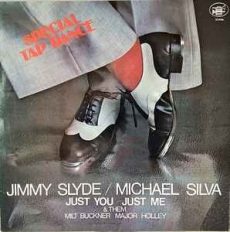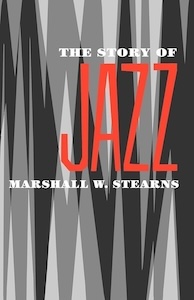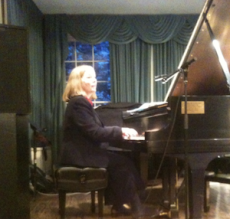
Daily Dose Of Jazz…
Michael Silva was born on November 12, 1925 in New York City, New York. After World War II he worked with Hot Lips Page, Milt Buckner Trio, the Robert Mavounzy Quintette and others. For a decade beginning in 1958 he was a member of Sammy Davis Jr.’s band.
In 1971 he settled in Paris, France where he recorded two albums with Ralph Sutton. Drummer Michael Silva died on March 8, 1990.
More Posts: bandleader,drums,history,instrumental,jazz,music

On The Bookshelf…
The Story Of Jazz | Marshall W. Stearns
Beginning with the African musical heritage and its fusion with European forms in America, Marshall Stearns’s history of jazz guides the reader through work songs, spirituls, ragtime, and the blues, to the birth of jazz in New Orleans, Louisiana and its adoption through the Great Migration by St Louis, Chicago, Kansas City, and New York.
The effect of jazz upon American culture and the American character has been all pervasive. This superlative history is the first and the most renowned systematic outline of the evolution of this Black American musical phenomenon. The book follows its course through the era of swing and bop to the beginnings of rock in the 50s, vividly depicting the great innovators, and covering such technical elements as the music’s form and structure.
The Story Of Jazz: 1956 | Marshall W. Stearns Oxford University Press

Daily Dose Of Jazz…
Lucy Galliher was born in Washington, D.C. on November 11, 1954. He graduated from Maret High School, received her BA in Music from Oberlin College and received a National Endowment for the Arts grant to study jazz piano with Joanne Brackeen. She went on to study at BMI Jazz Composer’s Workshop with Manny Albam, Roger Kellaway, Jim McNeely and also studied piano with Art Lande, Mark Levine, Barry Harris, and Hansi Alt.
She is on the faculty of Brooklyn-Queens Conservatory of Music and the Greenwich House Music School. She has held the position of East Coast Editor of Jazz Now Magazine, has performed on Broadway, cruise ships, recorded albums, and performed live in a variety of settings.
Pianist Lucy Galliher, who currently is an online Jazz Reviewer, continues to perform and record.
More Posts: bandleader,history,instrumental,jazz,music,piano

Daily Dose Of Jazz…
César Cardoso was born on November 10, 1982, in Leiria, Portugal. At only seven years old he dedicated his time to studying music, From 2004 to 2008 he studied at Hot Clube de Portugal’s Jazz School, where he had lessons with Jorge Reis and Pedro Moreira and started to distinguish himself as a jazz musician. 2008 had him enrolled at Escola Superior de Música de Lisboa, where he continued to work with Jorge Reis and Pedro Moreira. Completing a Jazz Bachelor Degree in saxophone performance, he became a member of the dixieland group Desbundixie with whom he recorded Kick’n Blow in 2007 and Up 2 Nine in 2009.
In 2010, César recorded his debut, Half Step, with his quintet at that time followed with a second album, Bottom Shelf, was released five years later in Hot Clube de Portugal, and features his original music this time written for His third album Interchange, was recorded with special guest, Miguel Zenón on alto saxophone.his quartet. His fourth album, Deice of Tenors, is a large ensemble recording.
He published the book Teoria do Jazz (Jazz Theory), with Chiado Editora, the first book ever written in Portuguese about the theoretical bases of Jazz, thought through to serve as a handbook for jazz students. His second book, a complement of the first, is titled Teoria do Jazz – Exercícios. Cardoso has composed and arranged for big bands, such as the Orquestra Jazz de Leiria and the Orquestra do Hot Clube de Portugal.
Saxophonist César Cardoso has won awards, became the first Portuguese musician to become an Artist Henri SELMER Paris, completed his PhD in Music and Musicology, and continues to perform, compose, arrange and teach at the Universidade de Évora in the Jazz degree program and is the pedagogical director of Escola de Jazz de Leiria.
More Posts: bandleader,history,instrumental,jazz,music,saxophone

Daily Dose Of Jazz…
César Cardoso was born on November 10, 1982, in Leiria, Portugal. At only seven years old he dedicated his time to studying music, From 2004 to 2008 he studied at Hot Clube de Portugal’s Jazz School, where he had lessons with Jorge Reis and Pedro Moreira and started to distinguish himself as a jazz musician. 2008 had him enrolled at Escola Superior de Música de Lisboa, where he continued to work with Jorge Reis and Pedro Moreira. Completing a Jazz Bachelor Degree in saxophone performance, he became a member of the dixieland group Desbundixie with whom he recorded Kick’n Blow in 2007 and Up 2 Nine in 2009.
In 2010, César recorded his debut, Half Step, with his quintet at that timefollowed with a second album, Bottom Shelf, was released five years later in Hot Clube de Portugal, and features his original music this time written for His third album Interchange, was recorded with special guest, Miguel Zenón on alto saxophone.his quartet. His fourth album, Deice of Tenors, is a large ensemble recording.
He published the book Teoria do Jazz (Jazz Theory), with Chiado Editora, the first book ever written in Portuguese about the theoretical bases of Jazz, thought through to serve as a handbook for jazz students. His second book, a complement of the first, is titled Teoria do Jazz – Exercícios. Cardoso has composed and arranged for big bands, such as the Orquestra Jazz de Leiria and the Orquestra do Hot Clube de Portugal.
Saxophonist César Cardoso has won awards, became the first Portuguese musician to become an Artist Henri Selmer Paris, completed his PhD in Music and Musicology, and continues to perform, compose, arrange and teach at the Universidade de Évora in the Jazz degree program and is the pedagogical director of Escola de Jazz de Leiria.
More Posts: bandleader,history,instrumental,jazz,music,saxophone



